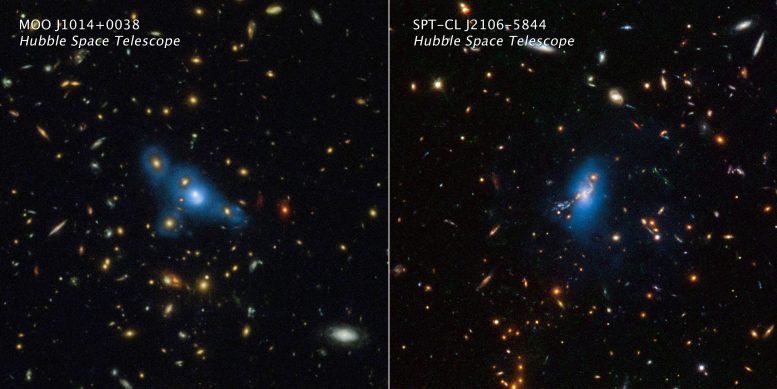Στην τηλεοπτική εκπομπή επιστημονικής φαντασίας Lost in Space της δεκαετίας του 1960, μια μικρή οικογένεια επίδοξων πλανητικών αποίκων εκτροχιάζεται και χάνεται στον γαλαξία μας. Αλλά η αλήθεια είναι πιο περίεργη από τη φαντασία όταν πρόκειται για αυτήν[{” attribute=””>Hubble Space Telescope discoveries. Thanks to Hubble, astronomers now know about entire families of stars – and presumably their planetary systems – that don’t even have a galaxy to call home. We are nestled inside the sprawling Milky Way galaxy, an empire of stars. But there are many stars wandering about inside giant clusters of hundreds or thousands of galaxies. These stars are not gravitationally tied to any one galaxy in a cluster. The nighttime sky would appear inky black and starless to any inhabitants orbiting their parent sun, save for the feeble soft glow of neighboring galaxies peppering the sky.
Collectively, the dim dispersed glow from these wayward stars forms a background called intracluster light that is evidence they are lurking around. Although the first clues came in 1951, Hubble can easily detect this light even though it’s 1/10,000th the glow of the night sky as seen from the ground-based telescopes. Billions of years ago galaxies would have been smaller than seen today, and they probably shed stars pretty easily because of a weaker gravitational pull. (The escape velocity from our Milky Way is over 1 million miles per hour). Understanding the origin of intracluster light could give astronomers new insights into the assembly history of entire galaxy clusters.

These are Hubble Space Telescope images of two massive clusters of galaxies named MOO J1014+0038 (left panel) and SPT-CL J2106-5844 (right panel). The artificially added blue color is translated from Hubble data that captured a phenomenon called intracluster light. This extremely faint glow traces a smooth distribution of light from wandering stars scattered across the cluster. Billions of years ago the stars were shed from their parent galaxies and now drift through intergalactic space. Credit: Science: NASA, ESA, STScI, James Jee (Yonsei University), Image Processing: Joseph DePasquale (STScI)
Hubble Space Telescope Finds that Ghost Light Among Galaxies Stretches Far Back in Time
In giant clusters of hundreds or thousands of galaxies, innumerable stars wander among the galaxies like lost souls, emitting a ghostly haze of light. These stars are not gravitationally tied to any one galaxy in a cluster.
The nagging question for astronomers has been: how did the stars get so scattered throughout the cluster in the first place? Several competing theories include the possibility that the stars were stripped out of a cluster’s galaxies, or they were tossed around after mergers of galaxies, or they were present early in a cluster’s formative years many billions of years ago.
A recent infrared survey from NASA’s Hubble Space Telescope, which looked for this so-called “intracluster light” sheds new light on the mystery. The new Hubble observations suggest that these stars have been wandering around for billions of years, and are not a product of more recent dynamical activity inside a galaxy cluster that would strip them out of normal galaxies.
The survey included 10 galaxy clusters as far away as nearly 10 billion light-years. These measurements must be made from space because the faint intracluster light is 10,000 times dimmer than the night sky as seen from the ground.
The survey reveals that the fraction of the intracluster light relative to the total light in the cluster remains constant, looking over billions of years back into time. “This means that these stars were already homeless in the early stages of the cluster’s formation,” said James Jee of Yonsei University in Seoul, South Korea. His results were published in the January 5 issue of Nature magazine.

Image of galaxy clusters MOO J1014+0038 (left panel) and SPT-CL J2106-5844 (right panel) captured by Hubble’s Wide Field Camera 3, with color key, compass arrows, and scale bar for reference.
This image shows near-infrared wavelengths of light. The color key shows which filters were used when collecting the light. The color of each filter name is the color used to represent the wavelength that passes through that filter.
The compass graphic points to the object’s orientation on the celestial sphere. North points to the north celestial pole which is not a fixed point in the sky, but it currently lies near the star Polaris, in the circumpolar constellation Ursa Minor. Celestial coordinates are analogous to a terrestrial map, though east and west are transposed because we are looking up rather than down.
The scale bar is labeled in light-years (ly) and parsecs (pc).
A light-year is the distance that light travels in one Earth-year. (It takes 100,000 years for light to travel a distance equal to the length of the bar.) One light-year is equal to about 5.88 trillion miles or 9.46 trillion kilometers.
A parsec is also a measure of length or distance. One parsec is approximately 3.26 light-years across.
Note that the distance in light-years and parsecs shown on this scale bar applies to the galaxy cluster, not to foreground or background objects.
Credit: Science: NASA, ESA, STScI, James Jee (Yonsei University), Image Processing: Joseph DePasquale (STScI)
Stars can be scattered outside of their galactic birthplace when a galaxy moves through gaseous material in the space between galaxies, as it orbits the center of the cluster. In the process, drag pushes gas and dust out of the galaxy. However, based on the new Hubble survey, Jee rules out this mechanism as the primary cause for the intracluster star production. That’s because the intracluster light fraction would increase over time to the present if stripping is the main player. But that is not the case in the new Hubble data, which show a constant fraction over billions of years.
“We don’t exactly know what made them homeless. Current theories cannot explain our results, but somehow they were produced in large quantities in the early universe,” said Jee. “In their early formative years, galaxies might have been pretty small and they bled stars pretty easily because of a weaker gravitational grasp.”
“If we figure out the origin of intracluster stars, it will help us understand the assembly history of an entire galaxy cluster, and they can serve as visible tracers of dark matter enveloping the cluster,” said Hyungjin Joo of Yonsei University, the first author of the paper. Dark matter is the invisible scaffolding of the universe, which holds galaxies, and clusters of galaxies, together.
If the wandering stars were produced through a comparatively recent pinball game among galaxies, they do not have enough time to scatter throughout the entire gravitational field of the cluster and therefore would not trace the distribution of the cluster’s dark matter. But if the stars were born in the cluster’s early years, they will have fully dispersed throughout the cluster. This would allow astronomers to use the wayward stars to map out the dark matter distribution across the cluster.
This technique is new and complementary to the traditional method of dark matter mapping by measuring how the entire cluster warps light from background objects due to a phenomenon called gravitational lensing.
Intracluster light was first detected in the Coma cluster of galaxies in 1951 by Fritz Zwicky, who reported that one of his most interesting discoveries was observing luminous, faint intergalactic matter in the cluster. Because the Coma cluster, containing at least 1,000 galaxies, is one of the nearest clusters to Earth (330 million light-years), Zwicky was able to detect the ghost light even with a modest 18-inch telescope.
NASA’s James Webb Space Telescope’s near-infrared capability and sensitivity will greatly extend the search for intracluster stars deeper into the universe, and therefore should help solve the mystery.
Reference: “Intracluster light is already abundant at redshift beyond unity” by Hyungjin Joo and M. James Jee, 4 January 2023, Nature.
DOI: 10.1038/s41586-022-05396-4
The Hubble Space Telescope is a project of international cooperation between NASA and ESA. NASA’s Goddard Space Flight Center in Greenbelt, Maryland, manages the telescope. The Space Telescope Science Institute (STScI) in Baltimore, Maryland, conducts Hubble and Webb science operations. STScI is operated for NASA by the Association of Universities for Research in Astronomy, in Washington, D.C.

“Ερασιτέχνης διοργανωτής. Εξαιρετικά ταπεινός web maven. Ειδικός κοινωνικών μέσων Wannabe. Δημιουργός. Thinker.”


